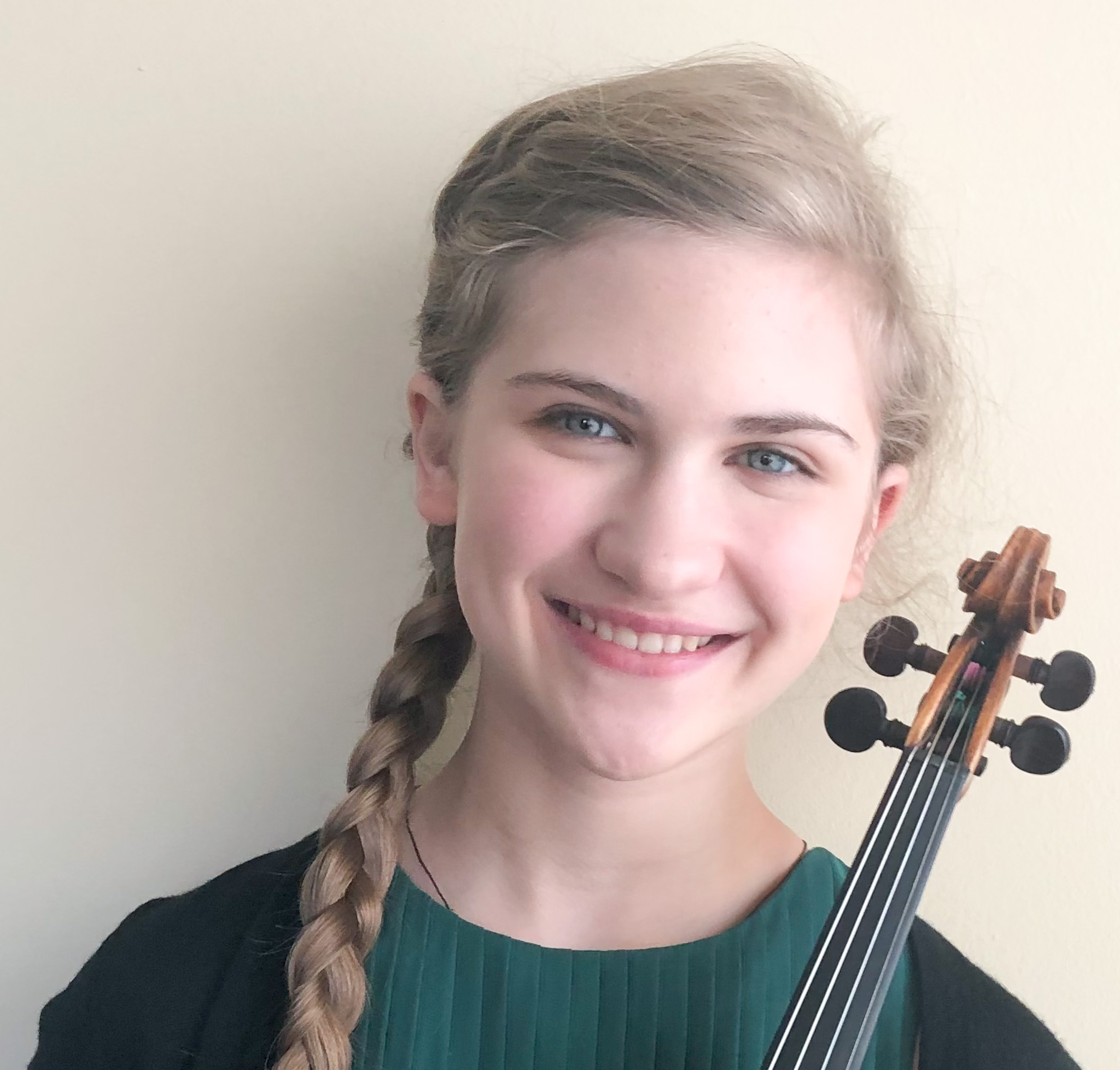Youth Outreach Week
Fri. Jul 28 Lake Harriet Band Shell 7:30pm
4135 West Lake Harriet Parkway, Minneapolis
Rain site: Basilica of St. Mary, 88 N 17th Street, Minneapolis (8:00pm)
Featuring Composer Kevin Chen
and Violin Soloist Cecilia O’Malley
Program
Dreams of FlightKevin Chen
Sinfonia commission and world premiere
Introduction and Rondo Capriccioso, opus 28Camille Saint-Saëns
Cecilia O’Malley, violin (winner of the Minnesota Sinfonia Young Artist Competition, Senior Division)
Symphony No. 7 in A Major, opus 92Ludwig van Beethoven
Poco sostenuto, vivace
Allegretto
Presto
Allegro con brio
 Kevin Chen is a thirteen-year-old composer who has been writing music since the age of five. At age eight, he started formal composition studies with Dr. Sarah Miller at the MacPhail Center of Music. Kevin also studies piano at MacPhail, where he won first place in the 2017 Upper Midwest Music Festival. Other accomplishments at MacPhail include winning the 2020 and 2022 Concerto & Aria Competition, performing twice in the Junior Honors Recital, and performing once in the Honors Recital.
Kevin Chen is a thirteen-year-old composer who has been writing music since the age of five. At age eight, he started formal composition studies with Dr. Sarah Miller at the MacPhail Center of Music. Kevin also studies piano at MacPhail, where he won first place in the 2017 Upper Midwest Music Festival. Other accomplishments at MacPhail include winning the 2020 and 2022 Concerto & Aria Competition, performing twice in the Junior Honors Recital, and performing once in the Honors Recital.
In 2019, Kevin won the Minnesota Sinfonia Young Composers Contest, and his Scherzo was performed at the Sinfonia’s Summer Season Finale Classical Concert. Kevin is also a multiple-time winner of the Minnesota Music Teachers Association’s Composition Contest and the National Federation of Music Clubs Junior Composers Contest. In 2022, he won first place in the North Central Class II division of the National Federation of Music Clubs’ composition contest. He is now in eighth grade and enjoys writing music and computer programming in his free time. Outside of music, he swims and plays tennis and likes to take walks with his dog.
 Cecilia Marie O’Malley is the winner of this year’s senior division of the Sinfonia’s Young Artist Competition, and winner of the $500 cash prize sponsored by the community’s premiere string shop, All Strings Attached. Age 15, Cecilia is an accomplished violinist, cellist and pianist who lives in Hot Springs, South Dakota. She has received multiple awards including from the Society of American Musicians, Robert Stanger Concerto Competition, Walgreen’s National Concerto Competition, Confucius Fine Arts Competition, and the Oistrakh Concerto Festival on both violin and cello. She loves collaborating with fellow musicians in orchestra and chamber ensembles, and soon will be touring with the South Dakota Youth Orchestra. Cecilia performs extensively in chamber groups on piano, violin, and cello.
Cecilia Marie O’Malley is the winner of this year’s senior division of the Sinfonia’s Young Artist Competition, and winner of the $500 cash prize sponsored by the community’s premiere string shop, All Strings Attached. Age 15, Cecilia is an accomplished violinist, cellist and pianist who lives in Hot Springs, South Dakota. She has received multiple awards including from the Society of American Musicians, Robert Stanger Concerto Competition, Walgreen’s National Concerto Competition, Confucius Fine Arts Competition, and the Oistrakh Concerto Festival on both violin and cello. She loves collaborating with fellow musicians in orchestra and chamber ensembles, and soon will be touring with the South Dakota Youth Orchestra. Cecilia performs extensively in chamber groups on piano, violin, and cello.
Currently, Cecilia plays cello with Trio Fiammifero, which was featured at the Pilgrim Players’ Stars of Tomorrow Concert and was selected as the Overall Winner in this year’s Midwest Young Artist Conservatory (MYAC) Chicago Chamber Music Competition.
Cecilia has spent her summers at the Meadowmount Institute of Music, Intermountain Advanced Strings Camp, Suzuki Institute’s DFW-WOW Advanced Strings Camp, MYAC Intensive Chamber Camp, Tutti Chamber Music Camp and the Fry Street Quartet Chamber Intensive Camp in Utah. In August of 2023, she will be at the Musique Dans le Gers Festival in France to perform on both violin and cello with her chamber group and the Black Oak Ensemble. Currently, she is studying with Gerardo Ribeiro of Northwestern University on violin, Dr. Tanya Carey of Roosevelt University on cello, and Ms. Tatyana Stepanova on piano.
In her free time, Cecilia enjoys horseback riding, cooking, reading British literature, studying French, watching old movies (from the 1930s-50s), and cuddling with her dog, Jack!
Program Notes
Introduction and Rondo CapricciosoCamille Saint-Saëns (1835-1921)
Composed in 1863 at the request of the very young and talented violin virtuoso Pablo de Sarasate, the Introduction and Rondo Capriccioso has become one of the most popular works in the entire violin repertoire. In 1859, Sarasate was only eleven years old when Saint-Saëns composed his first violin concerto for the already famous violinist. So it came as no surprise that in 1863 (when Sarasate was the ripe old age of fifteen), the composer was asked to write something that Sarasate described as “fresh and young as spring itself.” Saint-Saëns remembered the violinist as a young man who had “the faint shadow of a moustache scarcely visible on his upper lip, he was already a famous virtuoso. As if it were the easiest thing in the world, he had come quite simply to ask me to write a concerto for him.”
There were other notable composers who were part of the Who’s Who of the composers’ world, and who were also charmed by and composed for the violinist. Max Bruch, Eduoard Lalo, Joseph Joachim, Henri Wieniawski, and Antonín Dvořák were all part of this “club.”
The Introduction and Rondo Capriccioso is a nine-minute work that begins with a rather stately and singing (almost operatic?) opening, followed by what can only be described as a dazzling array of pyrotechnics and fireworks, all to show off the remarkable skills of the performer. The piece immediately became part of the standard repertoire, and after Georges Bizet (the French composer who created the opera Carmen) transcribed the orchestral accompaniment for piano, the Introduction and Rondo Capriccioso also made its way into recital halls, both for established violinists, and also for aspiring and very talented students. jf
Symphony No. 7 in A Major, opus 92Ludwig Van Beethoven (1732-1827)
Ludwig Van Beethoven was born in Bonn, Germany in 1770 and died in Vienna, Austria in 1827. He is probably best remembered as the genius who went deaf at an early age, yet still created some of the most famous and popular symphonic works of all time. Nearly everyone knows the opening of his Fifth Symphony (arguably the most famous four notes in history), and many of his works have been performed at important political and historical events all over the world (including the fall of the Berlin Wall and President John Kennedy’s funeral).
Beethoven was an idealist who believed in the beauty of nature and the betterment of mankind. He expressed his ideals in many of his works, including the Sixth Symphony (the Pastoral), which was about nature (and was used by Walt Disney in “Fantasia”), and of course in his Ninth Symphony. In the last movement of the Ninth Symphony, he created a choral and orchestra setting of Schiller’s “Ode to Joy.” The poem and the music dealt with brotherhood and joy – very uplifting and Utopian ideals.
Originally, the Third Symphony was to be dedicated to Napoleon, who also expressed ideals of equality, brotherhood, etc. But when Napoleon declared himself emperor, Beethoven became enraged and ripped up the dedicatory page, and exclaimed, “So he too is no different from an ordinary man! Now he too will trample on all human rights and pander only to his ambition; he will now set himself above all others and become a tyrant!” The title page was rewritten, and the new name simply became Sinfonia Eroica (heroic symphony).
The Seventh Symphony was finished in 1811, but its first performance did not occur until December 8, 1813, when the end of Napoleon’s reign was in sight. The Seventh Symphony and Wellington’s Victory appeared on the same program and were dedicated to the Austrian soldiers who were injured fighting Napoleon.
Many famous composers (including Salieri, Hummel, Spohr, and Meyerbeer) played in the orchestra for the premiere performances, and comments by Louis Spohr provides a good description of the proceedings:
The new compositions of Beethoven pleased extremely, particularly the Symphony in A; the wonderful second movement was encored and also made upon me a deep and lasting impression. The execution was a complete masterpiece, in spite of the uncertain and frequently laughable direction of Beethoven.
In fact, the success was so impressive that two additional performances had to be hastily arranged. What seems ironic now is that the success of the premiere, and what is now considered one of Beethoven’s greatest symphonies, was largely dependent on Wellington’s Victory, a novelty piece with battle sounds, etc., and which (at the time) became one of Beethoven’s most popular works. In fact, much to Beethoven’s chagrin, a German critic suggested that the Seventh Symphony was simply a “companion” piece to Wellington’s Victory.
The Seventh Symphony was composed in the key of A Major – a bright and “happy” key. Interestingly, there is no slow movement. Traditionally, and for most classical symphonies, second movements were slower in nature, generally labeled as “andante” (walking speed), or something even slower. They were meant as contrasts and perhaps a time to recoup after listening to the opening, and generally fast and involved, first movements. The second movement was labeled as an “allegretto,” a tempo that is meant to move along (a notch below “allegro,” which was the normal opening speed for classical symphonies’ first movements). Certainly, this movement has gravitas, but it should not be treated in a “normal” second movement fashion, as if it were a typical slow movement. This “allegretto” became very popular, and often was played out of context on its own.
During one of the subsequent performances of the Seventh Symphony, the Leipzig Allgemeine musikalische Zeitung reported
the new symphony (A major) was received with so much applause, again. The reception was as animated as at the first time; the Andante [which was really the “allegretto”] (A minor), the crown of modern instrumental music, as at the first performance, had to be repeated.
With Wellington’s Victory all but fading from contemporary public performances, the Seventh Symphony now rightfully receives the performances and public adoration that it justly deserves. jf
Please click here for all concert dates!

